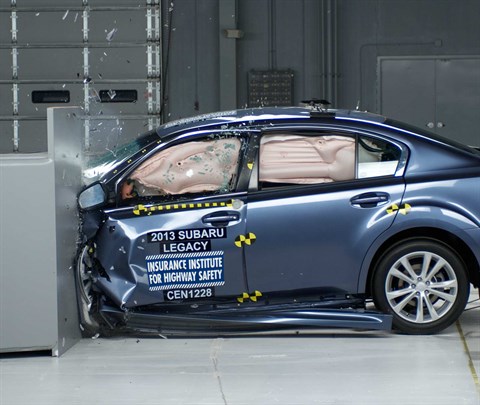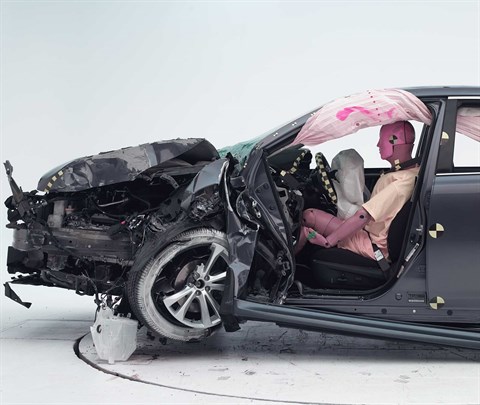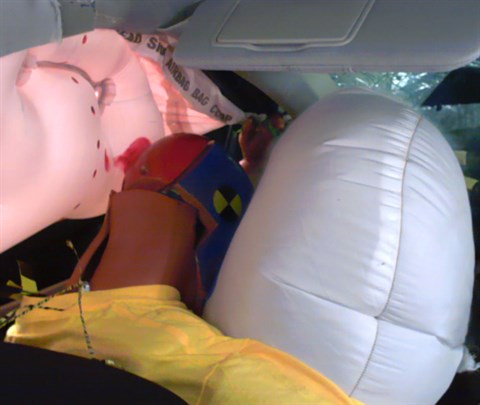Small overlap front: driver-side
Rating applies to 2013-14 models built after August 2012
Tested vehicle: 2013 Subaru Legacy 2.5i Premium 4-door 4wd
The Subaru Legacy was redesigned for the 2010 model year. Beginning with 2013 models built after August 2012, the side curtain airbags were reprogrammed to deploy in small overlap frontal crashes to improve occupant protection (note: information about when a specific vehicle was manufactured is on the certification label typically affixed to the car on or near the driver door). The tested car was built after the side airbag modification was in place.
The small overlap frontal crash test ratings also apply to the station wagon version of the Legacy, known as the Outback, also with the reprogrammed side curtain airbags beginning with 2013 models built after August 2012.
| Evaluation criteria | Rating |
|---|---|
| Structure and safety cage | |
| Driver injury measures | |
| Head/neck | |
| Chest | |
| Hip/thigh | |
| Lower leg/foot | |
| Driver restraints and dummy kinematics | |

Action shot taken during the small overlap frontal crash test.

The dummy's position in relation to the door frame, steering wheel, and instrument panel after the crash test indicates that the driver's survival space was not maintained well.

The frontal and side curtain airbags worked well together to keep the head from coming close to any stiff structure or outside objects that could cause injury.

Despite considerable intrusion into the driver footwell area, risk of injuries to the dummy's legs and feet was low.
Moderate overlap front: original test
Rating applies to 2010-14 models
Tested vehicle: 2010 Subaru Legacy 4-door 4wd
The Subaru Legacy was redesigned for the 2010 model year. Frontal ratings are assigned by the Institute based on a test conducted by Subaru.
The moderate overlap frontal crash test ratings also apply to the station wagon version of the Legacy, known as the Outback, also redesigned for 2010.
| Evaluation criteria | Rating |
|---|---|
| Overall evaluation | |
| Structure and safety cage | |
| Driver injury measures | |
| Head/neck | |
| Chest | |
| Leg/foot, left | |
| Leg/foot, right | |
| Driver restraints and dummy kinematics | |
Side: original test
Rating applies to 2010-14 models
Tested vehicle: 2010 Subaru Legacy 4-door 4wd with standard front and rear head curtain airbags and standard front seat-mounted torso airbags
The Subaru Legacy was redesigned for the 2010 model year. Side ratings are assigned by the Institute based on a test conducted by Subaru.
| Evaluation criteria | Rating |
|---|---|
| Overall evaluation | |
| Structure and safety cage | |
| Driver injury measures | |
| Head/neck | |
| Torso | |
| Pelvis/leg | |
| Driver head protection | |
| Rear passenger injury measures | |
| Head/neck | |
| Torso | |
| Pelvis/leg | |
| Rear passenger head protection | |
Roof strength
Rating applies to 2010-14 models
Tested vehicle: 2010 Subaru Legacy 2.5i Premium 4-door 4wd
| Overall evaluation | |
|---|---|
| Curb weight | 3,373 lbs |
| Peak force | 16,693 lbs |
| Strength-to-weight ratio | 4.95 |
Head restraints & seats
Seat type: All seats
| Overall evaluation | |
|---|---|
| Dynamic rating | |
| Seat/head restraint geometry |
About the head restraint & seat test
Currently, IIHS tests apply only to front seats.
